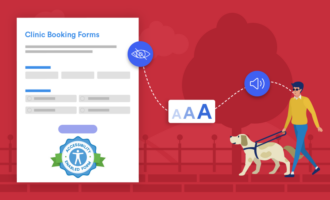In the 1970s, lawmakers began implementing legislation establishing the rights of people with disabilities in the U.S., specifically that they have equal access to services and information. While early regulations were primarily focused on physical spaces, over time the laws expanded to address the digital realm as well.
Today, there are a number of regulations that require technology, devices, and websites to be accessible to everyone, including people with physical and cognitive disabilities.
To help you ensure your website meets accessibility standards, we’ve created a seven-chapter guide about Section 508 compliance (the legislation that requires federal websites to be accessible) and web accessibility. Check out our chapter synopsis below:
Introduction to accessibility. What is accessibility, and how does it relate to the web?
Accessibility is for everyone. Accessibility features not only benefit those with disabilities but also those without. Find out how accessibility can improve the digital experience you provide to all visitors.
Origins of Section 508 and WCAG. This amendment played a big role in bringing web accessibility to the forefront. Discover the history behind this legislation.
How does Section 508 differ from the Americans with Disabilities Act (ADA)? Section 508 may seem similar to the ADA, but there are some important differences.
How to make your technology Section 508 compliant. What rules and regulations do you have to follow to ensure your website is compliant?
Some Section 508 exceptions. This chapter notes a few outlier situations where compliance isn’t required.
How to make online forms accessible. Web accessibility applies to online forms, too. This chapter offers a solution for creating compliant forms.
Introduction to accessibility
Before working to make your website accessible, it’s important to first understand what accessibility means. Merriam-Webster defines accessibility as “capable of being reached, or capable of being seen or used.”
While the concept of accessibility is generally broad, it’s often used in the context of disability rights — specifically that people with disabilities have the right to access and interact with products, environments, and services in the same way as those without disabilities.
The mention of an accessible service or establishment might conjure up images of a wheelchair ramp or braille signs. These are both examples of regulations set forth in the Americans with Disabilities Act (ADA) of 1990, which prohibits discrimination against people with phsyical and cognitive disabilities.
Glen Schubert, executive vice president of marketing at Braille Works, explains, “It was a whole course of action designed to help people with certain disabilities have access to the things that everybody else has access to.”
This act required businesses and state and local governments to adhere to certain architectural standards enabling accessibility. An example, according to Andrew Kirkpatrick, head of accessibility at Adobe, is countertop height requirements, which ensure people in wheelchairs can easily access counters in public spaces.
Though the ADA was an extremely important piece of legislation, it wasn’t the only law to address accessibility. The Rehabilitation Act of 1973 was actually the first law to provide federal civil rights protection for people with disabilities in the U.S. It determined that no federal agency could deny benefits or participation to people with disabilities.
However, as technology advanced, there became a stronger need for legislation to address accessibility in the digital space.
Web accessibility
When the internet became popular in the 1990s, a new issue arose: web accessibility. It became important to ensure that everyone, disability or no disability, could access and interact with the web equally.
Although the ADA did mention accessibility in relation to technology, it didn’t outline specific technical standards in the way it did for physical spaces. New legislation was needed to develop more detailed expectations and guidelines.
In response to these changing times, in 1998, legislators amended the Rehabilitation Act of 1973 with the addition of Section 508. This law required government Information and Communications Technology (ICT) to be accessible to people with disabilities in the same manner that it’s available to everyone else.
A year later, the World Wide Web Consortium (W3C), an international organization that determines standards for the web, introduced the first set of Web Content Accessibility Guidelines (WCAG). These guidelines were the first attempt to address specific web accessibility criteria, and they continue to grow and adapt with changes in technology. Today, Section 508 compliance means that federal agencies meet the criteria set forth in WCAG.
In the following chapters, we further discuss the importance of web accessibility, the history of associated legislation, and the ways you can make your website compliant.
Accessibility is for everyone
Accessibility is usually associated with making services and information more accessible for people with physical disabilities, but it actually benefits a much wider audience. In fact, making information easier to obtain and consume can improve everyone’s lives.
This post will discuss how web accessibility benefits people with and without disabilities and then touch on universal and inclusive website design principles that focus on making the web more accessible for everyone.
Accessibility for people with disabilities
Accessibility is geared toward people with physical disabilities in a lot of ways. The Americans with Disabilities Act (ADA) set standards to make physical spaces more inclusive and accessible for people with limited mobility, hearing loss, and vision loss, among other disabilities. The Section 508 amendment to the Rehabilitation Act of 1973 did the same for technological spaces.
When a website is deemed “accessible,” that means it doesn’t have any barriers preventing people with physical disabilities from consuming and interacting with its content. For example, someone who cannot use a traditional keyboard can still navigate the website, and someone who is blind can access the information without seeing it.
The ADA also protects people with cognitive disabilities. These disabilities cover a wide range of conditions, from Alheizmer’s disease to autism spectrum disorders.
Because they’re sometimes more difficult to define, the guidelines for providing assistance aren’t as cut and dried as those for physical disabilities. However, in terms of web accessibility, content that’s well organized, understandable, and easy to navigate will be easier for people with cognitive disabilities to digest. Ensuring there are no distractions, such as busy backgrounds or alternating text styles, can help, too.
Accessibility for people without disabilities
João Figueiredo, accessibility consultant and creator of the online accessibility tool Aditus, compares accessibility to an elevator: An elevator can help someone with a disability easily arrive on another floor, but it can also help someone without a disability achieve the same thing.
Web accessibility is similar. While its principles may be geared toward those with disabilities, it actually benefits everyone.
Haris Karim, digital strategist at MAB Accessibility, says text that’s larger and contrasts with the background of a website makes it easier for everyone to read. The same goes for making buttons and links intuitive with graphic and textual directions, as it improves usability for all visitors. This is especially true for eldery people, who may not fall under the category of disabled but may have a limited understanding of the internet or need larger text to read the content.
Universal and inclusive website design
Web designers can apply two design principles to help make websites usable by the greatest number of people: universal and inclusive.
Robert Kingett, an accessibility consultant and the blogger behind Blind Journalist, explains, “Universal design is the design of products and environments to be usable by all people, to the greatest extent possible, without the need for adaptation or specialized design.”
On the other hand, “inclusive design takes disabilities into account when designing websites.” He says inclusive design involves thinking about your audience and designing specialized accessibility aspects that work well for people both with and without disabilities.
When it comes to designing your website, you don’t choose one or the other; you can use both principles in tandem to make your website accessible to the widest possible audience. For example, universal design might consider the text placement or use of white space to make the site easier for everyone to read, while inclusive design takes into account the screen reader and ensures that it will properly interpret that text.
Sharon Rosenblatt, director of communications at Accessibility Partners, LLC, stresses that accessibility helps keep communication on a level playing field. Because so much information is shared in different ways, we must be careful not to shut anyone out.
In the following chapter, we’ll discuss Section 508, which addresses web accessibility standards and expectations.
Origins of Section 508 and WCAG
Legislation covering accessibility dates back to the 1970s, but technology advancements, such as the internet, have made it necessary to revisit those laws. That’s where Section 508 and Web Content Accessibility Guidelines (WCAG) come into play. Section 508 prohibits barriers in information technology, while WCAG set web accessibility standards.
In this chapter, we’ll discuss the origins of Section 508 and WCAG and how they affect website development specifically.
History of Section 508
In 1998, Congress amended the Rehabilitation Act of 1973 to include Section 508, a federal law requiring all federal agencies to make their government information and communications technology (ICT) accessible to people with disabilities in the same manner that it’s available to everyone else. This includes telephones, software, websites, and multimedia. The law mandated that not only must these technologies be accessible for federal employees, but they must be accessible to the general public, too.
Glen Schubert, executive vice president of marketing at Braille Works, explains that this legislation accomplished far more than just making it easier for disabled people to visit websites and read blogs. Section 508 made it possible for them to use technology to access their personal data — everything from financial documentation to health information — online.
Since government agencies were now legally required to provide accessible information and technology to those with disabilities, the need arose for standardized guidelines that businesses could follow and comply with.
Introduction to the Web Content Accessibility Guidelines (WCAG)
The World Wide Web Consortium (W3C) is an international organization that sets standards for the World Wide Web. W3C began addressing web accessibility guidelines as early as 1994, but it wasn’t until 1999 that the organization published the first set of Web Content Accessibility Guidelines (WCAG).
Version 1.0 outlined 14 principles of accessible website design and how to implement them. Cary Coppola, CEO of Blue Compass, explains that WCAG 1.0 was the gold standard for web accessibility when it was first released, but as technology continued to advance, it quickly became outdated and certain aspects were no longer relevant.
To keep up with the tech industry, W3C revised the guidelines and developed WCAG 2.0 in 2008, and, more recently, WCAG 2.1 in 2018, which further builds on the 2.0 concepts.
While WCAG 1.0 focused on the techniques to use to make your website accessible, the newer versions spell out the aspects that make a website accessible in the first place. These versions are more likely to stand the test of time, because the standards and expectations will remain the same even as technology itself advances.
It’s important to note that the latest version, 2.1, has not yet been formally adopted by most countries (including the U.S.), so in terms of W3C compliance, version 2.0 is the current standard.
WCAG conformance levels
WCAG 2.0 provides three levels of compliance: A, AA, and AAA. Each level outlines a layer of checkpoints that gets deeper in terms of complexity.
- Level A outlines the basic, bare minimum accessibility requirements that a web page must meet. A Level A site will not meet all the needs of people with disabilities, but it’s considered beneficial to a wide range of visitors.
- Level AA addresses some of the biggest challenges users with disabilities face. A Level AA site will accommodate the needs of most people.
- Level AAA outlines the highest standards of accessibility, which cover more advanced barriers some people with disabilities face. As noted in the WCAG guidelines themselves, it’s not necessary for all web pages to follow these criteria because some elements aren’t possible to implement for all types of content.
Coppola says that, while the more rigorous conformance level AAA is nice to reach for, it can be expensive and sometimes difficult to meet. Most of his clients strive to achieve the WCAG 2.0 AA level, which offers reasonable accommodation and is considered the industry standard.
In addition to the conformance levels, WCAG 2.0 has four principles of accessibility, known as POUR. If your website fails to incorporate these principles, it’s considered inaccessible. The four principles of WCAG 2.0 are as follows:
- Perceivable: Are all the elements on the page detectable to everyone? Examples may include adjustable font sizes and alt-text descriptions for images.
- Operational: Can everyone interact with the website regardless of disability? Users must be able to navigate and access all information on the site.
- Understandable: Can all users understand the content and the instructions on the site?
- Robust: Is the content accessible on all kinds of devices? The website must be compatible with assistive technologies.
For a more in-depth look at web accessibility standards, check out our blog post on the topic.
Now that you know the history of web accessibility, we’ll discuss how Section 508 differs from the Americans with Disabilities Act (ADA).
How does Section 508 differ from the Americans with Disabilities Act (ADA)?
Section 508 and the Americans with Disabilities Act (ADA) both focus on accessibility. Though similar in what they protect, there are a few slight differences between the two.
Americans with Disabilities Act (ADA)
President George H.W. Bush signed the Americans with Disabilities Act into law in 1990. This civil law made it illegal to discriminate based on disability. It required businesses in the private and public sector, nonprofit services, and state and local governments to provide reasonable accommodations for those with disabilities.
The ADA requires organizations to meet specific criteria relating to physical spaces, such as countertop height and wheelchair ramp requirements. Although the ADA does cover technology, it doesn’t provide the same guidelines for the digital realm as it does for physical spaces.
Section 508
To address the need for standards within technology, in 1998, Congress amended the Rehabilitation Act of 1973 to include Section 508. It required federal agencies to make their electronic and information technology accessible to everyone. Glen Schubert, executive vice president of marketing at Braille Works says it deals with how information is delivered, making sure that people with a visual, cognitive, or physical impairment have the same access to electronic content as people without disabilities.
This amendment came at a time when the internet was beginning to play a much bigger role in the lives of Americans. Personal and financial information was now living online; however, without special accommodations, many people with disabilities had difficulty using these systems. For example, they couldn’t digitally review their VA benefits, Social Security claims, or student loans in the same way as the rest of the public.
Section 508 addressed these issues by outlining technical standards for making web content more accessible. It was a significant step, because it gave people with disabilities the freedom to manage their own information.
Main differences between ADA and Section 508
The ADA and Section 508 differ in four main areas: audience, purpose, scope, and penalties.
Audience
The ADA pertains to a much larger audience than Section 508, as it includes all kinds of businesses and agencies, from nonprofits to state governments. It covers both public and private entities, such as banks, restaurants, hotels, and schools.
Meanwhile, Section 508 only requires federal departments and federally funded agencies to adhere to the law and doesn’t cover the private sector.
Purpose
Although both laws are geared toward making the world more accessible, they do have slightly different purposes. The ADA prohibits discrimination against people with disabilities and assures they have the same opportunities as those without disabilities.
Section 508 only covers equal access to electronic and information technology associated with the federal government.
Scope
The ADA has a broad scope — it requires accommodations in all public places, across all types of public transportation, within government services, and in telecommunications. The ADA does cover the digital space but not in as much detail as Section 508.
Alternatively, Section 508 only refers to information and communications technology (ICT), that encompasses websites, software, digitally published material, and telephones.
Penalties
Failing to meet ADA compliance carries a heavy fine. According to ADA.gov, first-time violators could face fines of up to $75,000, while a second violation could cost a maximum of $150,000.
Section 508 violations could lead to formal complaints or civil lawsuits, and/or the loss of an agency’s federal funding.
Though there are some differences between these laws, they work in tandem, making the world more equal and accessible for people with disabilities.
In the next chapter, we’ll discuss how to make your business 508 compliant.
How to make your technology Section 508 compliant
Section 508, the 1998 amendment to the Rehabilitation Act of 1973, requires federal agencies to make all technical and electronic information accessible to everyone, including those with disabilities. This means all government websites and technology must adhere to the guidelines outlined in Section 508.
To check your technology against those standards, you’ll need to do Section 508 compliance testing. One way to do that is with the Section 508 compliance checklist provided in a Voluntary Product Accessibility Template (VPAT); another is to evaluate your website through a web accessibility checker.
Section 508 compliance checklist
Natalie MacLees, founder and principal at Digitally, formally known as Purple Pen Productions, explains, “The federal government is committed to procuring only accessible technology, and the VPAT was created as a standard way for companies to communicate about the accessibility of their technology products to the federal government employees making decisions.”
If you deal with any kind of information and communication technology — products, hardware, software, or electronic content — a VPAT will provide the information you need to ensure you’re properly testing your product against the appropriate criteria. (For reference, check out the VPAT for Jotform’s online Form Builder.)
The template includes instructions and guidelines for understanding and interpreting the standards, which pertain to Section 508 and the Web Content Accessibility Guidelines (WCAG).
The template also provides a checklist to evaluate how a particular product fares against each criterion associated with accessibility compliance. This checklist is the portion that potential buyers or consumers will review to determine the product’s level of accessibility.
Web accessibility checkers
Web accessibility checkers are web apps or browser add-ons that look for major barriers that could prevent someone with a disability from interacting with and understanding your website. These tools identify areas of improvement that would help make your website accessible to the greatest number of visitors.
A web accessibility checker will evaluate aspects of your web content against WCAG and Section 508. For example, WCAG contrast checkers determine if your website has the appropriate contrast levels; others search for audio descriptions, alt-text on your images, and properly labeled headers, all of which make it easier for people with disabilities to navigate and consume web content.
The following are examples of some of the most popular website checkers, according to accessibility experts:
- Axe helps prioritize the issues it finds and is considered one of the most in-depth tools.
- Functional Accessibility Evaluator (FEA) provides a performance status on each issue it detects.
- AChecker identifies known problems, likely problems, and potential problems.
- WAVE evaluates the website from a technical perspective and is best suited for designers and developers.
It’s important to note that, “while automated accessibility checkers are convenient and can catch some major blockers, they are only capable of checking for 20–30 percent of possible accessibility issues on a site,” explains MacLees.
These tools are a great starting point, but manual testing is required to identify all possible issues. For more in-depth information on web accessibility checkers, check out our blog post.
Regardless of whether you use a VPAT or a web accessibility checker to assess your technology, your product evaluator must have a strong understanding of Section 508 and WCAG. The more familiar it is with the standards, the more accurate your assessment will be.
Though the federal government and federally funded agencies are required by law to follow Section 508, there are a few exceptions to the rule, which we’ll discuss in the next chapter.
Some Section 508 exceptions
Under Section 508, all federal agencies must make their information and communication technology (ICT) accessible to people with disabilities.
ICT refers to all technology that provides access to information through telecommunications, including cell phones, computers, and the internet. It covers hardware, software, and electronic content, too.
Though all federal agencies are required to adhere to the law, there are a few Section 508 exceptions.
Section 508 exceptions
To determine if you can claim an exemption, the ICT must fall under one of the following categories: legacy, national security system, federal contract, maintenance location, undue burden, or best meets exceptions.
Legacy ICT
ICT that met the standard as it was outlined before January 18, 2018, and that has not been subsequently changed in a way that affects interoperability or the user interface, is not required to meet the Revised 508 Standards.
National security system
If the ICT is part of a national security system as determined by 40 u.s.c. 11103(a), it may qualify as an exception. Examples include ICT involving intelligence activities and equipment associated with weapons systems.
Federal contract
This exception applies if a contractor or vendor is the owner of the ICT and is the only party accessing and interacting with it. If ownership switches to the federal government, or if the government procures it, then this exception doesn’t apply.
Functions located in maintenance or monitoring spaces
If the ICT is located in an environment that’s only serviced by maintenance or repair personnel, then it may meet this exception. The ICT must have physical controls (status indicators or operable parts) in order to qualify.
Undue burden
If adhering to the 508 standards would cause an undue burden or alter the nature of the ICT, compliance isn’t required. However, Gabe Turner, a lawyer and director of content at Security Baron, explains, “It’s left ambiguous of what constitutes an ‘undue burden,’ so that’s up for legal interpretation.” The U.S. General Services Administration recommends consulting with legal experts who have experience with undue burden claims.
Best meets
If a business requires ICT that may not be fully accessible, but there are no other commercially available options, then the technology must meet the 508 Revised Standards to the best of its ability.
If you believe your ICT falls under one of these exceptions, you may need formal approval from an agency representative to file a claim. Refer to your agency’s accessibility policy to determine next steps.
In our final chapter, we’ll discuss how online forms must meet Section 508 standards, too.
How to make online forms accessible
As we’ve discussed, web accessibility benefits everyone, not just those with disabilities. It makes aspects of the web easier to read, understand, and navigate. Just as with other parts of a website, online forms should comply with accessibility standards.
The importance of accessible forms
Online forms are common. You might use one when you’re entering payment information for a purchase or filling out a job application. If you’re using the internet to buy a plane ticket, complete a survey, or book an appointment, chances are, you’re using an online form.
Because these forms are such a big part of interacting with the web, it’s crucial to provide everyone with equal access.
What makes an accessible form?
- Properly labeled fields
- Simple navigation
- Logical organization
- Keyboard accessibility
- User feedback about errors and successful completions
- Clear instructions
Properly labeled fields are important — it should be clear where you enter your name versus where you fill in your address. When fields are correctly labeled and coded, you can easily navigate the page. In fact, your computer may even autofill the information for you.
Sharon Rosenblatt, director of communications at Accessibility Partners, LLC, explains that, if fields are mislabeled, information could be entered improperly. This is especially the case if someone relies on a screen reader to identify each field. Without knowing where the correct information belongs, it may take longer to organize the information and sort out the error. While this is just a nuisance for some, it could be the difference between someone successfully completing that form or not.
How Jotform has become accessible
Since online forms play a big role on the web, Jotform now offers assistance to ensure every form created by our users complies with WCAG and Section 508.
When using Jotform, you can choose one of our accessible templates or build your own form with the guidance of a built-in accessibility checker. However, you must first turn on the accessibility option. We hope to roll out the feature to all of our forms in the near future. For more information on our new accessibility features, check out our blog.
As you create your form, the tool alerts you when a component of your form isn’t accessible. Once you’ve addressed all the accessibility elements, your form will receive an accessibility badge, indicating that it meets the standards.
You must enable the feature on each form, but
Although our form templates meet the WCAG and Section 508 standards, we wanted to put them to the test. We invited Çağrı Artan, a blind coordinator at Istanbul Technical University, to navigate through four different forms as a usability test. Based on Artan’s experience and feedback, we continue to improve and research our accessibility features.
Want to know more about our user-testing with Artan? Read more on our blog.
How to make your Jotform form accessible
Begin by picking your desired template and then enabling the Form Accessibility option under Form Settings. Also, click Show accessibility badge on the form.
When you navigate back to your form, you’ll see messages about accessibility issues. The feature will highlight errors with your widgets, fields, and colors. For example, it may recommend you change your color scheme, or detect that you haven’t labeled each field. Learn more about the step-by-step process.
Other ways of making your form accessible include using an easy-to-read font, making sure instructions are clear, and avoiding flashing or blinking images. Check out additional things to consider when building an accessible form.
Once you’ve addressed each issue, you’ll receive the accessibility badge, which lets users know your form meets accessibility standards.
Building an accessible form opens up the doors to more users, allowing everyone to interact and engage with your content. Discover how easy it is to create an accessible form of your own.








Send Comment: